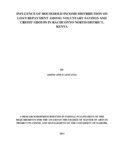| dc.description.abstract | Community based financial institutions provide financial services to the poor who have been marginalized by traditional financial institutions in rural and urban areas. Reaching the poor is harder and less profitable for traditional financial institutions as the poor; lack the ability to borrow and save in amounts that would be profitable for traditional financial institutions, lack the collateral required to borrow finances, and are dispersed and hard to reach. The sustainability and viability of MFIs (Micro Financial Institutions) is important to make sure that MFIs can continually provide financing to MEs (Micro Entreprises) without depending on donors and government. Therefore, financial sustainability is a prerequisite for making micro financial services permanent as well as widely available (ICC, 2001).This study was initiated in order to examine the influence of household income distribution on loan repayment among Voluntary Savings and Credit group members in Rachuonyo District. Itwas guided by the following four objectives; to establish the extent to which household expenditure on food influence loan repayment among voluntary savings and credit group members, to examine the extent to which household expenditure on education influence loan repayment among voluntary savings and credit group members, to assess the extent to which income generating activities within households influence loan repayment among voluntary savings and credit group members and finally to determine the extent to which asset acquisition within households influence loan repayment among voluntary savings and credit group members in Rachuonyo North District. The study adopted a descriptive survey design with qualitative and quantitative approaches to data collection. Using the table of sample size selection by Glenn, D. Israel (1992), a sample size of 191 respondents at 7% precision wasdrawn from a total of 2013 members who are practicing VSL (Voluntary saving and Loaning methodology) within groups in the targeted 4 sub locations. Stratified, purposive and random sampling techniques wereapplied in selecting targeted respondents per sub location.The study further employed in depth interviews to obtain qualitative information to help understand respondents’ views and experiences with regard to VSL and loan repayment. The collected data was analyzed using descriptive statistics in the form of frequencies and percentage tables with the aid of SPSS (Statistical Packages for Social Scientists). Findings from both qualitative and quantitative data collection were fed into each other and later triangulated with the findings from review of related documents.The following findings emerged from the analysis of collected information; Majority of VSL group members eat three meals a day, spend heavily on food and depend on the market as their main source of food, a factor that would negatively influence loan repayment among VSL group members.Majority of VSL group members have between 1 – 6 children mainly in primary and secondary schools and therefore spent most of their income on education related expenses. The highest proportion of VSL group members engage in small scale businesses i.e. shop keeping and grocery businesses with most of them acquiring capital from own savings and VSL group loan. The average monthly income from businesses was established to be between sh.1000-10000 for majority of the members which is mostly spent on food.This can be detrimental to the survival of the businesses. Majority of the respondents acquired assets in form of livestock (sheep, goats, chicken), household wares, farming equipment and bicycle using VSL group loan, but did not face challenges in repaying the loans.This is a clear indication that VSL group loans have positively impacted on the lives of its members by empowering them to purchase assets. When loans are associated with an increase in assets, the vulnerability of the very poor is reduced and their poverty situation improves. | en_US |

